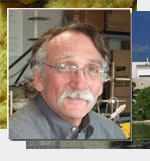Thomas Torgersen
(Ph.D., Columbia University) Professor of Marine Sciences, emeritus
Geochemistry is primarily concerned with the evaluation of the dynamics of chemical processes in various Earth systems. To accomplish this task, geochemistry employs a variety of naturally occurring tracers and radioisotopes to calibrate mass balances and mass transport models that range from simplistic to mathematically elegant. My primary research involves:
1. Environmental Dynamics, Hydrology and Aqueous process geochemistry: (1) coupling among physical, chemical and biological processes in the environment; (2) thresholds and response times within environmental systems; (3) ocean dynamics and coupled ocean-continent systems; (4) limnology and stream chemodynamics, (5) sediment tracers and processes, groundwater radiochemistry, environmental transport analysis, oceanographic tracers, large-scale fluid flow and reactions, (6) rock fracturing and tectonic relations to fluid flow and ore genesis;
2. Geochemistry of helium and rare gases, natural radiochemical tracers and anthropogenic tracers: (1) quantification of advection, dispersion and mixing processes in 1,2,3D using natural tracers; (2) quantification of reaction rates in the environment with tracer techniques; (3) observing systems aqueous environmental processes including high resolution x,y,z,t and lagrangian drifters; (4) orogenic fluids, groundwater dating and basin analysis
I have recently developed a suite of in situ monitors (BORIS) that allow us to investigate stratification, mixing, carbon, oxygen and nutrient chemodynamics on the 15 minute timescale. This reveals the coupling of physical, chemical and biological processes in shallow systems. This will enable the investigation of the dynamics of tidal flats and coastal runoff to LIS that is necessary to understand the coupling of the land use and coastal ocean processes.
Other projects have included the quantification of transport rates of Long Island Sound bottom water which couple with the oxygen consumption terms to produce hypoxia in western LIS. Using the distribution of 222Rn and/or 224Ra in the bottom water, a measured value of the horizontal eddy diffusivity was obtained that can explain the temporal dynamics of oxygen loss in the water column. Another project involved the use of 224Ra as a tracer of salt marsh nutrient coupling to the nutrient budget of LIS. Using this radioisotope, we were able to quantify the net cycling of water through dispersed salt marshes and assess their impact on the LIS nutrient cycle
Another current project is examining the role of fluids in the San Andreas Fault System. The current explanation favored for low friction slip along the San Andreas Fault Zone (SAFZ) is the presence of superhydrostatic fluid pressures, which can only be tested by direct sampling and fault plane drilling. Since fluid transport is subject to wide variation in both time and space, the in situ measurement of pressure gradients and permeability in a fault zone drill hole will establish the current conditions BUT provide little indication of pressure/transport patterns over the time interval for pressurization cycles of the fault (decades). The project will determine the flow of fluids into/from the fault zone using noble gas methodologies and especially helium isiotopes. Pore fluid ages and age gradients will indicate the magnitude and direction of fluid flow into/from the San Andreas Fault Zone on the longest time scales.
Research Projects
Air-derived noble gases in sediments: implications for basin scale hydrogeology. – Department of Energy
Scientific Drilling/San Andreas Fault: fluid transport analysis â rare gas âagesâ of matrix porosity fluids in drill core. – National Science Foundation
Oceanography Alumni
John R. Bean – M.Sc. 2005
Janina Benoit – M.Sc. 1990
Brett F. Branco – Ph.D. 2007
Edward Deangelo – M.Sc. 1993
Yin Sun – Ph.D. 1998
Publications
Branco, B.F., T. Torgersen, J.R. Bean, G. Grenier, and D. Arbige. 2005. A new water column profiler for shallow aquatic systems. Limnol. Oceanogr. Methods 3:190-202
Torgersen, T., B. Branco and J. Bean. 2004. Chemical Retention Processes in Ponds. Environmental Engineering Science. 21: 149-156.
Sun, Y. and T. Torgersen. 2001. Adsorption-desorption reactions and bioturbation transport of Ra-224 in marine sediments: a 1D model with applications. Marine Chemistry 74: 227-234.
Bethke, C., X. Zhao and T. Torgersen. 1999. Groundwater flow and the 4He distribution in the Great Artesian Basin of Australia. J. Geophys. Res. 104: 12999-13011.
Torgersen, T. and B.M. Kennedy. 1998. Air-Xe enrichments in oil field gases and the influence of water during oil migration and storage. Earth Planet. Sci. Lett. 167: 239-253.
Torgersen, T., E. DeAngelo and J. O’Donnell. 1997. Calculations of horizontal mixing rates using 222Rn and the controls on hypoxia in western Long Island Sound. Estuaries 20: 328-343.
Torgersen, T., K.K. Turekian, V.C. Turekian, N. Tanaka, E. DeAngelo and J. O’Donnell. 1996. 224Ra distribution in surface and deep water of Long Island Sound: sources and horizontal transport rates. Cont. Shelf Res. 16: 1545-1559.
Turekian, K.K., N. Tanaka, V.C. Turekian, T. Torgersen and E.C. DeAngelo. 1996. Transfer rates of dissolved tracers through estuaries based on Ra-228: a study of Long Island Sound. Cont. Shelf Res. 16: 863-873.
Torgersen, T., S. Drenkard, M. Stute, P. Schlosser and A. Shapiro. 1995. Mantle helium in New Hampshire (USA) groundwater: time and space constraints on sources. Geology 23: 675-678.
